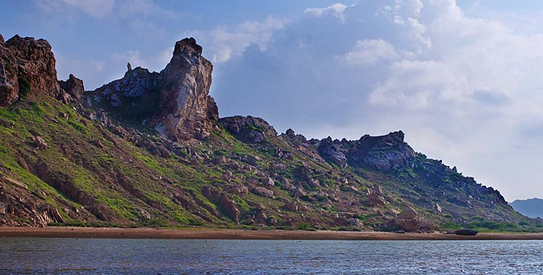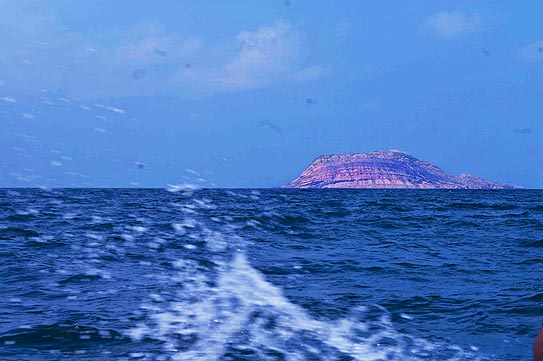
Almost two weeks ago, on September 25, it was the International Reef Cleaning Day. Like most people in Karachi, I wasn’t even aware that we had coral reefs in our waters – much less people to clean them or even divers who explore them. So I was very surprised when I was invited by Yousuf Ali of the Karachi Scuba Diving Center (KSDC), to accompany them on a diving trip to clean and explore the coral reef off Charna Island.
As I soon found out, the KSDC has been organising these reef cleaning trips every September for a number of years, and many divers come to Charna Island annually to help clean the young, fast-growing reef, and explore the rich waters that surround the island.
I quickly agreed to accompany Ali’s team on the trip. On a beautiful Sunday morning I stood in Ali’s scuba center in Defence as he showed me where we were going. On a map of the coastline, he explained how most of the areas were inaccessible for various reasons: Clifton beach was too polluted, and various other locations along the shoreline were either restricted areas or unfriendly waters for diving. “Charna Island however is not one of these places; it was an ideal spot for diving, fishing and exploring marine-life,” he said.
As we set off, I also met eight other members of the group. Among them were student divers and first-timers who would be guided and coached by Ali and Rosheen Khan. Rosheen, I was amazed to learn, is Pakistan’s first certified female diving instructor.
To reach Charna Island we had to drive to Sonera Beach (near Mubarak Village) by following a road that turns off the main Hawkesbay route and leads to the Hub power plant. From the map I had noticed that it is this area where the Hub River turns into a delta and flows into the sea.
The rocky hills on the way were covered in sparse but green wild grass, which provided for a rolling, scenic route that eventually gave way to our destination on the shores of Sonera Beach.
After loading the scuba tanks and equipment aboard one of the many fishing boats that were shored there, our combined group slowly headed out from the muddy banks and began the 10-kilometre trip towards the island.
The environment was pristine and majestic, the hills around us were grand and the water that swayed our boat was a dozen shades of blue. As we entered the open sea and the water turned darker and choppier, I used the 90 minute boat-ride to take in my surroundings and find out more about Charna as it slowly drew closer and clearer.

Ali explained that the reef around the island started growing rapidly after the 2005 earthquake and tsunami, and has since become an underwater haven for a huge variety of fish and plants that flourish in the rich, shallow waters. The KSDC has been diving at Charna regularly and documenting the progress of the coral as it evolved from just a layer of bright green moss-like growth on the underwater rocks – to a full fledged eco-system.
He also pointed out the Hub power plant, clearly visible across the water – and explained how the plant draws seawater in for cooling purposes, and then empties it back into the sea. “This causes a slow but regular increase in the water temperature, which is one of the major threats to the fragile underwater eco-system that is very sensitive to these changes,” he added.
Even after Ali described the huge variety of flora and fauna (including barracuda, tuna, oysters, ray fish and turtles) that had been seen and documented by them in the coral reef, I still had the urge to ask the number one question that any first-time diver wants to ask.
“Are there any sharks?” I said with a childish grin.
“Yes sometimes we have seen some Blacktip sharks,” responded Ali with a smile.
Blacktips get their name from the black borders they have on the edges of their fins. I didn’t know whether I was more disappointed or relieved when he added that they were quite rare.
“However, on one recent trip, another group of divers also encountered a Whale Shark,” he added.
The Whale Shark is a magnificent creature. They can reach a size of up to 10 metres and are not only the largest sharks, but also the largest species of fish in the world. Despite their intimidating name, Whale Sharks are more “whale” than “shark” in their attitude as they feed mainly on plankton and are very docile.
I was excited before I even came on the trip, but after this I could barely contain my enthusiasm. Everything about the experience so far had defied my expectations about what I thought could be found and done so close to home and in our own country – from the expertise of these local divers to the quiet beauty of the coastline. I was beginning to understand why Yousuf Ali and his compatriots were so passionately trying to keep this reef clean and healthy.
When we finally reached the Charna Island, we dropped anchor and the team started to check and prepare their scuba gear. I looked over the boat and saw that the water was pretty clear and calm: the waves would hit the island on its opposite side, but behind it we were protected from them.

While they prepared we asked if it was okay to go in the water and swim around. Ali explained that the scuba-divers would go in twos or threes and take turns going under, so while we waited we could safely have a swim.
The water was pleasantly warm and about 15 to 20 feet deep; except for a few jellyfish here and there, I could spot no apparent signs of life as I swam on the surface and tried to peek under. But soon the first divers resurfaced and happily informed us that the visibility underneath was great and that there were a lot of fish to see.
In order to clean the reef the divers had also taken bags down with them to collect trash and debris polluting the reef. They found and brought back ropes, wrappers, pieces of fishing nets, and even some large metal pieces of what appeared to be shrapnel.
“In the past the navy used this island as a target for testing their weapons,” said Ali. “This is probably from a bomb.”

Rosheen and some of the other divers helped me get into the gear and systematically checked the pressure gauge, pipes and valves. They helped me sit up to the edge of the boat, put on my mask and mouthpiece, and gave me the signal to roll backwards into the water.
“We’ll follow this anchor-line down” said Ali, and instructed me on how to hold my nose and blow in order to pressurise my ears to the water as we gradually made our decent.
Once we went down, I was so occupied by the strange sensation of being able to breathe underwater, and the process of slowly pressurising my ears (they would start to hurt quite a bit every few feet) that I was surprised when I looked around and saw that we were twenty feet below the surface and almost standing on the seabed.
As we started to swim just above the sandy bed, I was surprised to see dozens of stingrays resting just underneath the surface. When we got near them they would dart off with a puff of sand and disappear by “flying” out of sight. As we swam a few metres further, we reached the actual reef. It was like entering a teeming village of fish and plant life.
Everywhere I looked I saw a new kind of creature. Small schools of fish swimming in formation, spiky sea urchins that clung to the rocks, and glittery striped angel fish that darted this way and that along the spongy red corral. We glided past glowing anemone, a puffer fish that eyed us suspiciously, and even moray eels that peeked in and out of the porous rock with their gaping mouths.

I could also feel the water temperature as it changed. Every few feet we would enter a slightly cooler zone and sink down a few feet, and then suddenly we would enter a warmer spot and float higher – I recalled what Ali had mentioned about the water temperature and was now experiencing firsthand how profoundly a few degrees of heat affect underwater life.
I had also seen some pollution in the water during my dive (wrappers floating around, old fishing lines and some ropes etc), but back on the boat as the crew discussed the dive, I was glad to hear that this year they had found the reef to be a lot cleaner and more populated than before.
On the way back as most of our group napped on the long boat-ride, I felt thrilled by my eye-opening experience: After seeing for myself the amazing hidden world below, I finally understood why these divers cared for it so much.
In a way, I also felt really proud that just a few hours from home in Karachi, it was possible to see and do such amazing things that I had assumed could only be experienced in other countries and in documentaries on television.
If anyone has a taste for adventure, a capacity to admire natural beauty, and a desire to discover one of the hidden wonders of our Pakistan, they should definitely plan a trip to Charna, and perhaps even a dive below.
Accompanying photos by the writer.
[nggallery id=3705]
Nadir Siddiqui is a photographer and interactive producer at Dawn.com. Follow him on twitter at here and view some of his photography here.









































